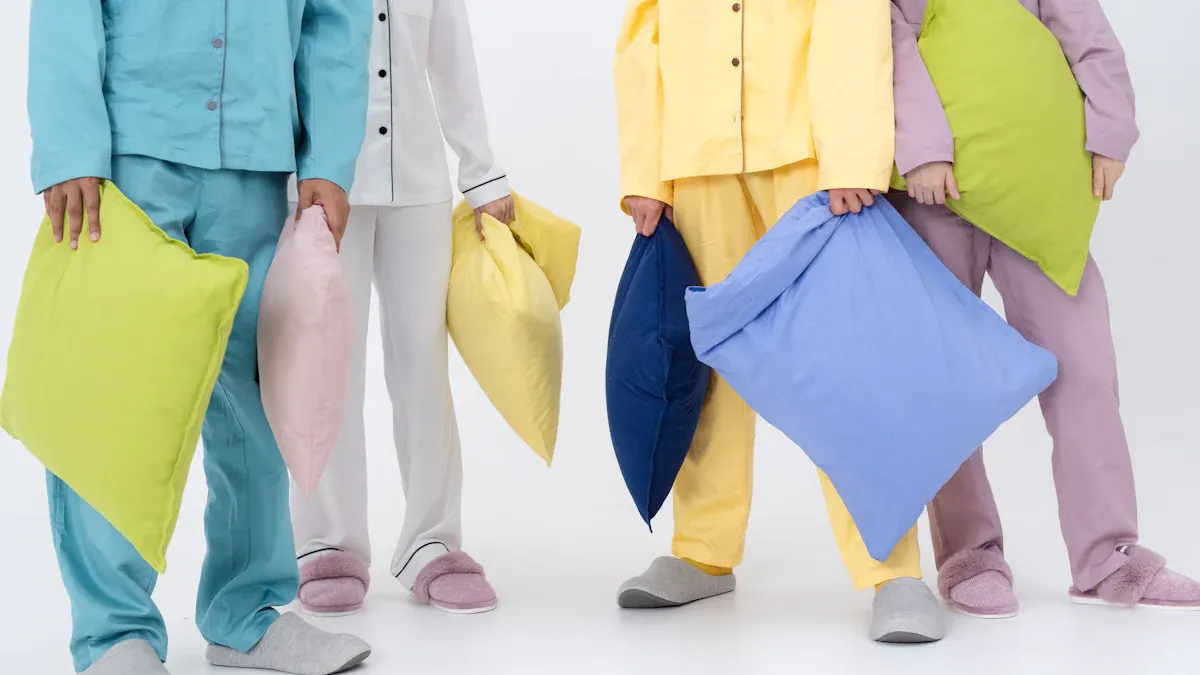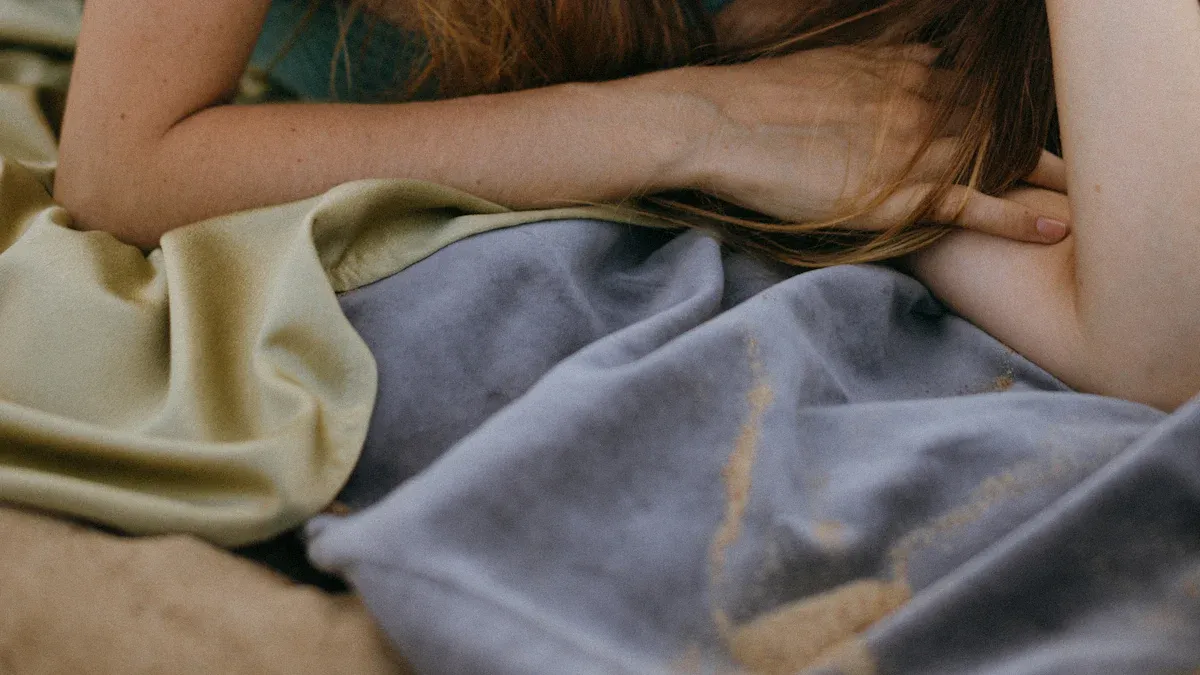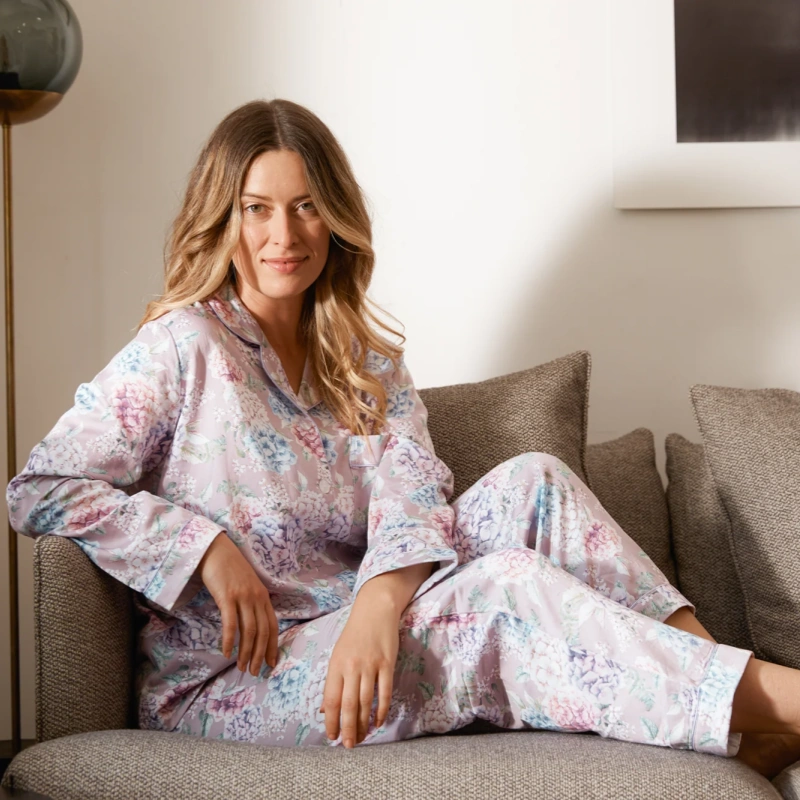
You want pajamas that feel amazing, breathe well, and keep you comfortable all night. So, is viscose good for pajamas? Yes, viscose offers a silky, smooth feel, making it a favorite for sleepwear lovers who crave softness. Compared to cotton, viscose and rayon feel lighter and drape like silk, while modal brings even more breathability and durability.
Cotton gives you classic comfort and easy care, but modal stands out for eco-friendliness. If you love pajamas that feel cool and luxurious, viscose and rayon deserve your attention.
Key Takeaways
Viscose pajamas feel soft, silky, and cool, making them great for comfort and breathability.
Modal pajamas offer the best softness, moisture control, durability, and easy care among the three fabrics.
Cotton pajamas provide classic comfort and breathability but may cling when wet and need more care to avoid shrinking.
Viscose needs gentle washing to keep its shape and softness, while modal is easier to care for and resists shrinking and fading.
Modal fabric is the most eco-friendly choice, using less water and energy, while viscose and cotton have higher environmental impacts.
Is Viscose Good for Pajamas
Direct Answer
If you want pajamas that feel soft, cool, and luxurious, viscose is a great choice. Many experts in sleepwear agree that viscose stands out for its comfort and breathability. You will notice that viscose pajamas feel smooth and light against your skin, almost like silk. This fabric lets air flow freely, so you stay cool and dry, even on warm nights.
Scientific research shows that viscose can help regulate your body temperature, which means you will not wake up sweaty or uncomfortable. When you compare viscose to cotton or modal, you get a fabric that feels softer and drapes better than cotton, but modal fabric offers even more durability and moisture control.
You might wonder, Is viscose good for pajamas if you sweat at night? The answer is yes. Viscose absorbs more moisture than cotton, so it keeps you dry and comfortable.
Modal fabric, however, takes moisture-wicking to the next level, making modal pajamas a better choice if you want the ultimate in dryness and softness. Still, many people love the silky touch and lightweight feel of viscose, especially if you want sleepwear that feels elegant without the high price of silk.
Main Pros and Cons
When you choose pajamas, you want to know the real benefits and drawbacks. Here is a quick look at how viscose stacks up:
Tip: If you want pajamas that feel cool, soft, and luxurious, viscose and rayon are top picks. If you want the best in moisture-wicking and durability, modal fabric is the better choice.
Main Strengths of Viscose Pajamas:
Silky, soft texture that feels gentle on your skin
Lightweight and breathable, perfect for hot sleepers
Absorbs more moisture than cotton, keeping you dry
Drapes beautifully, giving pajamas a high-end look
Holds color well, so your pajamas stay vibrant
Main Weaknesses of Viscose Pajamas:
Shrinks and wrinkles easily if you do not follow the care instructions
Weaker when wet, so you need to handle it with care
May lose shape after stretching
Needs gentle washing to keep quality high
Here is a quick comparison table to help you see how viscose, cotton, and modal stack up in moisture management and comfort:
Fabric | Moisture Regain Rate (%) | Breathability and Comfort Notes |
|---|---|---|
Viscose (Rayon) | 11-16 | Very breathable; holds more moisture than cotton; great for hot, low-humidity nights |
Cotton | 7-11 | Breathable but can cling to skin in humid weather, reducing comfort |
Modal | 11-14 | Exceptional softness and moisture-wicking; stays dry and resists shrinking |
You can see that viscose and modal both outperform cotton in moisture-wicking and breathability. Modal fabric also resists shrinking and fading, which adds to its advantages.
If you want pajamas that combine softness, breathability, and a touch of luxury, viscose and rayon are excellent. If you want the best in durability and moisture control, modal fabric is the better choice.
Comparison Table

Viscose vs Cotton vs Modal
When you shop for pajamas, you want to know the key differences between viscose, cotton, and modal.
Each fabric brings unique benefits to your sleepwear. You deserve pajamas that match your comfort needs, care preferences, and eco-values. Let’s break down how these fabrics compare in softness, breathability, durability, and more.
Attribute | Cotton | Viscose (Rayon) | Modal (Refined Viscose) |
|---|---|---|---|
Comfort | Soft, fluffy, classic feel | Silky, smooth, luxurious drape | Ultra-soft, smooth, gentle on skin |
Softness | Natural, less supple | High, silk-like, fluid | Highest, plush, retains softness |
Breathability | Excellent, cool in the heat | Good, airy, but can feel heavy and wet | Excellent, stays light and cool |
Durability | Strong, resists wear | Delicate, weakens when wet | Superior, resists shrinking/fading |
Care | Easy, machine washable | Needs gentle care, hand wash best | Easy, less wrinkling, machine wash |
Eco-Friendliness | Biodegradable, water-intensive | Biodegradable, varies by finish | Eco-certified, less water/energy |
You feel the difference as soon as you touch each fabric. Cotton fabric gives you a familiar, cozy softness. Viscose and rayon offer a silky, elegant touch that feels cool and smooth. Modal fabric takes softness to the next level, staying plush even after many washes.
Breathability matters for a good night’s sleep. Cotton lets your skin breathe, making it ideal for hot climates. Viscose and rayon also allow air to flow, but they can feel heavy if you sweat a lot. Modal keeps you cool and dry, thanks to its advanced moisture management.
Durability affects how long your pajamas last. Cotton stands up to frequent washing. Viscose and rayon need gentle care, so you must handle them with care. Modal fabric resists shrinking and fading, so your pajamas stay soft and vibrant.
Care and eco-friendliness also play a role. Cotton fabric is easy to wash, but it uses a lot of water to produce. Viscose is biodegradable, but its eco-impact depends on the dyes and finishes. Modal stands out for its eco-certifications and lower resource use.
Tip: When comparing modal vs cotton, think about your priorities. If you want the softest, most durable, and eco-friendly pajamas, modal fabric is your best bet. If you love classic comfort, cotton is a solid choice. For a silky, luxurious feel, viscose and rayon are hard to beat.
Comfort

Viscose
You want pajamas that feel soft and luxurious. Viscose delivers exactly that. This fabric comes from natural cellulose sources like wood pulp and bamboo. The production process transforms these materials into fibers that feel silky and smooth.
You will notice the softness and comfort as soon as you touch viscose pajamas. The lightweight nature and excellent drape make them feel almost like silk on your skin.
Viscose absorbs moisture well, which helps keep you cool at night.
The nanoscale pores in the fibers allow air to flow, boosting breathability.
You get a fabric that feels gentle and smooth, perfect for sensitive skin.
Viscose, also known as rayon, offers moderate breathability. It feels more breathable than many synthetic fabrics. You may find that viscose pajamas help regulate your body temperature, so you stay comfortable even if you sweat at night. The softness and comfort of viscose make it a popular choice for sleepwear.
Tip: If you want pajamas that combine a silk-like touch with moisture-wicking, viscose and rayon are excellent picks.
Cotton Fabric
Cotton stands as a classic choice for pajamas. You know cotton for its familiar, cozy feel. The softness of cotton fabric gives you instant comfort when you slip into bed. Cotton pajamas feel fluffy and gentle, making them ideal for everyday wear.
Cotton offers excellent breathability, letting your skin breathe all night.
The natural fibers absorb moisture, so you stay dry and cool.
Cotton fabric resists irritation, making it great for sensitive skin.
You will appreciate how cotton pajamas keep their softness after many washes. The comfort and breathability of cotton make it a reliable option for anyone who values a traditional sleepwear experience.
Modal Fabric
Modal fabric takes comfort to the next level. You will love the ultra-soft, silky, and cool feel against your skin. Textile experts praise modal for its exceptional softness and comfort. The fabric’s porous structure allows air to flow freely, enhancing breathability and moisture-wicking.
Modal fabric keeps you cool and dry, even on warm nights.
The gentle touch of modal makes it perfect for sensitive skin.
Modal pajamas maintain their softness and shape, wash after wash.
Rayon and modal both offer a luxurious feel, but modal fabric stands out for its superior softness and comfort. You get pajamas that help regulate your body temperature and keep you comfortable all night. Many top pajama brands use modal for its proven comfort benefits.
Note: If you want the ultimate in softness and comfort, modal fabric is the best choice for your sleepwear.
Breathability
Viscose
You want pajamas that keep you cool and dry. Viscose stands out for its impressive breathability. This fabric, also known as rayon, lets air move freely through the fibers. You feel the difference as soon as you slip on viscose pajamas. The lightweight structure and smooth surface help air circulate, so you stay comfortable all night.
Laboratory tests show that viscose fabric offers high air permeability, with values ranging from about 894.77 to 1034.10 mm/s. This means you get better airflow compared to cotton and even some modal fabric options. Viscose also absorbs moisture well, which helps with sweat control.
The high absorption rate keeps your skin dry and fresh. You will notice that viscose pajamas feel cool, especially in warm or humid weather. If you want sleepwear that combines breathability and moisture management, viscose is a smart choice.
Test Parameter | Viscose Fabric (Socks) | Cotton Fabric (Socks) | Modal Fabric (Socks) |
|---|---|---|---|
Air Permeability | 894.77–1034.10 mm/s | Lower than viscose | Comparable to Lyocell |
Moisture Regain | 7.51%–9.89% | Lower than viscose | 7.02%–9.28% |
Thermal Resistance | Larger in compact yarns | Lower than viscose | Larger in microfibers |
Tip: Choose viscose if you want pajamas that feel light, airy, and help you stay dry.
Cotton Fabric
Cotton remains a classic for sleepwear, but you should know how it performs in breathability. The breathability of cotton comes from its natural fibers, which allow air to pass through. You get a cool, comfortable feel, especially in dry climates. Cotton fabric absorbs moisture, but not as much as viscose or modal.
After wet pretreatment, cotton shows decreased air permeability. This means airflow drops when the fabric gets damp. Cotton pajamas still offer reliable comfort, but you may notice they cling to your skin if you sweat a lot.
If you want a familiar, cozy option, cotton is a solid pick. However, for maximum breathability and moisture-wicking, you might prefer modal or viscose.
Modal Fabric
Modal fabric takes breathability and absorption to the next level. You will love how modal keeps you cool and dry, even on hot nights. Textile research highlights several key benefits:
Modal fabric absorbs moisture about 50% more effectively than cotton.
The high absorption rate allows sweat to evaporate quickly, so you stay cool.
Modal’s breathability and moisture-wicking properties make it ideal for sleepwear.
The fabric feels soft and gentle, perfect for sensitive skin.
Modal pajamas help prevent skin irritation by allowing air to circulate.
You get pajamas that manage sweat better than cotton or rayon. Modal fabric’s advanced structure means you enjoy superior breathability and moisture control. If you want the best in comfort, dryness, and softness, modal is the top choice for sleepwear.
Durability
Viscose
You want pajamas that last, but viscose, also known as rayon, can show signs of wear sooner than you expect. The silky feel and beautiful drape of rayon make it a favorite for comfort, but its fibers weaken when wet. After just a few washes, you may notice pilling or roughness.
Standard rayon pajamas can lose their smooth finish and start to fade over time. Bamboo viscose offers a bit more strength than regular rayon, but it still does not match the long-term durability of modal fabric. If you love the luxurious touch of viscose, handle your pajamas with care to maintain their quality.
Tip: Always follow gentle washing instructions for viscose pajamas to help them keep their shape and softness.
Cotton Fabric
Cotton pajamas give you classic comfort and breathability. You probably enjoy how cotton fabric feels soft and cozy from the first wear. However, cotton tends to fade and wear out faster with repeated washing. Over time, you might see thinning fabric or color loss.
Cotton pajamas remain popular for their comfort, but they do not offer the absolute best in terms of longevity. If you want pajamas that stay vibrant and resist pilling, you may want to consider modal fabric instead. Cotton works well for everyday use, but it cannot compete with modal’s superior wear and tear resistance.
Cotton pajamas are traditional and comfortable.
They can fade and lose quality after many washes.
Cotton does not resist pilling as well as modal.
Modal Fabric
If you want pajamas that look and feel new for years, modal fabric stands out as the top choice. Modal undergoes a special refining process that strengthens its fibers, making it much more durable than cotton or rayon. You will notice that modal pajamas keep their softness, resist pilling, and hold color even after extended use.
Modal fabric rarely shrinks and maintains its shape, even when wet. You can enjoy the same luxurious feel for over two years of regular wear. Modal’s tight weave and long fibers give it excellent elasticity, so your pajamas keep their fit and quality.
When you want the absolute best in terms of longevity, modal fabric delivers unmatched performance.
Note: Modal pajamas resist fading, pilling, and shrinking, making them a smart investment for anyone who values quality and long-term durability.
Care and Maintenance
Viscose
You want your pajamas to stay soft and beautiful. Viscose needs gentle care because the fibers are delicate. Always hand wash your viscose pajamas in cold water with a mild detergent. Avoid wringing or twisting the fabric. This prevents fiber damage and keeps the silky texture.
Lay your pajamas flat to air dry or use a padded hanger. This helps them keep their shape and prevents stretching. Never use bleach or harsh chemicals. These can break down the fibers and ruin the color. If you need to remove wrinkles, use a steamer or iron on medium heat with a pressing cloth.
Machine washing can cause shrinkage or damage, so always check the care label. Some viscose pajamas are dry-clean-only. Store your pajamas in a cool, dry place and avoid plastic bins to prevent mildew. With the right care, you enjoy the silky feel and high absorption of viscose for a long time.
Tip: Treat viscose pajamas with care to keep their luxurious look and moisture-wicking comfort.
Cotton Fabric
Cotton pajamas are easy to care for and fit busy lifestyles. You can machine wash cotton in cold or warm water. Use a gentle cycle and mild detergent to protect the fibers. Cotton fabric handles frequent washing well, but avoid overloading the machine. This reduces friction and keeps your pajamas soft.
Tumble dry on low heat or hang to air dry. Cotton absorbs moisture well, so your pajamas stay fresh and comfortable. Iron on medium heat if needed. Avoid bleach, as it can weaken the fibers and fade colors.
Store your cotton pajamas in a dry, ventilated space. With proper care, you enjoy the classic comfort and high absorption of cotton for years.
Modal Fabric
Modal fabric makes care and maintenance simple. You can machine wash modal pajamas on a gentle cycle with cold water. Always sort by color and fabric type to prevent damage. Use mild, fragrance-free detergents to keep the fabric soft.
Modal resists shrinking and pilling better than cotton. You can tumble dry on low to medium heat or air dry flat on a towel. Avoid bleach and fabric softeners, as they weaken the fibers. Modal fabric offers excellent absorption and moisture-wicking, so your pajamas stay dry and comfortable.
Store modal pajamas in a cool, dry place away from sunlight. Regularly check for signs of wear and address them quickly. With these steps, you keep your modal pajamas soft, vibrant, and long-lasting.
Note: Modal fabric stands out for easy care, high absorption, and moisture-wicking, making it a smart choice for anyone who values convenience and comfort.
Environmental Impact
Viscose
You might love the silky feel of viscose pajamas, but you should know how this fabric affects the planet. Viscose production often causes serious environmental problems. Factories use wood pulp from forests, cutting down over 150 million trees each year. This leads to habitat loss and sometimes even harms endangered forests.
The process uses toxic chemicals like carbon disulfide and sulfuric acid. These chemicals can hurt workers and people living nearby. Many factories release untreated waste into rivers, turning the water black and harming wildlife. Water use is also high, which can strain local supplies.
Some companies now use better methods, like closed-loop systems, to recycle chemicals and reduce pollution. Choosing viscose made with these new methods, such as Tencel or ECOVERO, helps lower the impact.
If you want to support a cleaner planet, look for pajamas made with sustainable viscose or certified eco-friendly brands.
Cotton Fabric
Cotton is a classic choice for pajamas, but it comes with a heavy environmental cost. Growing cotton uses a lot of water, sometimes more than any other fabric. Farmers often use large amounts of pesticides, which pollute soil and water.
This can harm wildlife and even affect people living near cotton farms. Some types, like Pima cotton, use less water and fewer chemicals, but most cotton fabric still has a big footprint. When you choose cotton pajamas, you support a fabric that is natural and biodegradable, but you should be aware of its high resource use.
Fabric Type | Water Use | Pesticide Use | Other Notes |
|---|---|---|---|
Conventional Cotton | Very high | High | Most water- and pesticide-intensive option |
Pima Cotton | Lower | Lower | More durable, less waste |
Modal | Much lower | Minimal | Closed-loop, more sustainable |
Viscose | High | Not applicable | Toxic chemicals, pollution risk |
Modal Fabric
You can make a big difference by choosing modal fabric for your pajamas. Modal comes from beech trees, which need up to 20 times less water than cotton. These trees grow naturally and do not need replanting, so they help protect forests.
The production process uses less energy and fewer chemicals, especially when made by trusted brands like Lenzing. Modal fabric is biodegradable and breaks down quickly in landfills. Factories recycle almost all water and chemicals, keeping pollution low.
Modal also lasts longer, so you replace your pajamas less often, which helps the environment even more. If you want a soft, eco-friendly choice, modal fabric stands out as the best option for both comfort and sustainability.
Choose modal pajamas to enjoy comfort and help protect the planet at the same time.
Choosing Between Modal Fabric and Cotton
Best for Hot Sleepers
If you often wake up feeling hot, you want pajamas that keep you cool and dry. Modal pajamas work best for hot sleepers. The fabric absorbs moisture quickly and lets your skin breathe.
You stay comfortable all night, even in warm weather. Cotton also offers breathability, but modal pajamas manage sweat better and feel cooler against your skin. You will notice the difference after just one night.
Best for Sensitive Skin
Sensitive skin needs gentle fabrics. Both cotton and modal pajamas protect your skin from irritation. Cotton fabric is hypoallergenic and absorbs moisture, which helps prevent overheating and itching. You can wash cotton at high temperatures to remove allergens, making it a safe choice for eczema or allergies.
Organic cotton gives extra safety by avoiding harsh chemicals. Modal pajamas have a super smooth surface that reduces friction. Clinical studies show that modal helps reduce redness and itching for people with atopic dermatitis. You can trust both options for comfort, but modal pajamas offer a silkier touch.
Best for Easy Care
You want pajamas that look great with little effort. Modal pajamas stand out for easy care. They resist shrinking, fading, and wrinkling. You can pack them for travel and still enjoy a fresh look. Just wash modal in cold water on a gentle cycle and avoid high heat.
Cotton pajamas need more attention. Cotton wrinkles easily and can shrink if not pre-treated. You may need to iron cotton to keep it looking neat. If you want convenience, choose modal pajamas for simple, reliable care.
Best for Eco-Conscious Shoppers
If you care about the planet, modal pajamas are the top choice. Modal uses less water than cotton and comes from sustainable beechwood trees. The production process recycles water and chemicals, lowering its environmental impact. Modal is biodegradable and breaks down without leaving toxins.
Cotton is natural and biodegradable, but it uses much more water and often needs pesticides. Certifications like OEKO-TEX® and FSC support the modal’s eco-friendly claims. When you want comfort and sustainability, modal pajamas deliver both.
For custom pajama production with quality and care, Friendtex offers expert solutions for your brand.
Conclusion
You deserve pajamas that help you sleep well and feel great. Viscose gives you a silky touch and cool comfort, but modal stands out for softness, moisture-wicking, and easy care.
Cotton remains a classic for breathability and durability. If you want the better choice for comfort, care, and eco-friendliness, modal pajamas deliver on all fronts. Always pick what feels best for your skin and supports your values.
FAQ
What makes viscose pajamas feel so soft?
You feel the softness because viscose fibers mimic silk. The smooth surface glides over your skin. You enjoy a luxurious touch every night.
Tip: Choose viscose pajamas if you want a silky, elegant feel without the high price of real silk.
Are modal pajamas worth the investment?
Yes, you get long-lasting softness and vibrant color. Modal resists shrinking and pilling. You save money over time because your pajamas look new after many washes.
Can you machine wash viscose pajamas?
You should hand-wash viscose for the best results. If you use a machine, select a gentle cycle and cold water. Always check the care label first.
Which fabric is best for sensitive skin?
You want modal or cotton? Both feel gentle and reduce irritation. Modal offers extra smoothness, while cotton gives you a familiar, hypoallergenic touch.
How do I choose eco-friendly pajamas?
Look for modal pajamas. You support sustainable forestry and water-saving production. Certified brands help you protect the planet while enjoying premium comfort.


